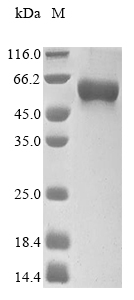In mammalian cells, the generation of recombinant dog phospholipase A2 group XV (PLA2G15) involves cloning a DNA fragment encoding the dog PLA2G15 protein (32-408aa) into a plasmid vector along with the N-terminal 10xHis-tag and C-terminal Myc-tag gene, which is then transferred into the mammalian cells. Positive cells are selected, cultured, and induced to express the PLA2G15 protein. Lysis of the cells allows for the harvest of the recombinant dog PLA2G15 protein. The collected recombinant dog PLA2G15 protein is subjected to affinity purification and is identified using SDS-PAGE and subsequent staining of the gel with Coomassie Brilliant Blue. Its purity is greater than 90%.
PLA2G15 is a lysosomal enzyme with unique subcellular localization to the lysosome and late endosome [1]. PLA2G15 has multiple functions, including the regulation of adipocyte differentiation [2], synthesis of 1- O -acylceramide [3], hydrolysis of lysophosphatidylcholine to glycerophosphorylcholine and a free fatty acid [4], and catalyzing the hydrolysis and degradation of cellular phospholipids [5]. Furthermore, PLA2G15 regulates lysophospholipids and is present in exosomes [6].
Studies have also linked PLA2G15 to specific conditions and diseases. For instance, it has been identified as part of an eight-gene expression signature for predicting high Fuhrman-grade renal cell carcinoma [7]. Furthermore, a novel intergenically spliced chimera, NFATC3-PLA2G15, has been associated with aggressive T-cell acute lymphoblastic leukemia biology [8]. Moreover, PLA2G15 is upregulated in the acute phase of COVID-19, indicating its involvement in the innate immune host response during the early stages of the disease [9].
Furthermore, PLA2G15 has been implicated in lipid metabolism, as evidenced by its association with the metabolism of steroid hormones and glycerol phosphate [10]. PLA2G15 has also been shown to regulate BMP lipids in hepatocytes [11]. Additionally, PLA2G15 has been identified as part of proteins involved in bile acid metabolism and lipid metabolism processes.
References:
[1] J. Shayman and J. Tesmer, Lysosomal phospholipase a2, Biochimica Et Biophysica Acta (Bba) - Molecular and Cell Biology of Lipids, vol. 1864, no. 6, p. 932-940, 2019. https://doi.org/10.1016/j.bbalip.2018.07.012
[2] P. Wilson, S. Gardner, N. Lambie, S. Commans, & D. Crowther, Characterization of the human patatin-like phospholipase family, The Journal of Lipid Research, vol. 47, no. 9, p. 1940-1949, 2006. https://doi.org/10.1194/jlr.m600185-jlr200
[3] Y. Ohno, N. Kamiyama, S. Nakamichi, & A. Kihara, Pnpla1 is a transacylase essential for the generation of the skin barrier lipid ω-o-acylceramide, Nature Communications, vol. 8, no. 1, 2017. https://doi.org/10.1038/ncomms14610
[4] X. Guo, S. Zhou, Z. Yang, Z. Li, W. Hu, L. Daiet al., Comprehensive analysis of sterol o-acyltransferase 1 as a prognostic biomarker and its association with immune infiltration in glioma, Frontiers in Oncology, vol. 12, 2022. https://doi.org/10.3389/fonc.2022.896433
[5] I. Shahi, C. Llaneras, S. Perelman, V. Torres, & A. Ratner, Genome-wide crispr-cas9 screen does not identify host factors modulating streptococcus agalactiae β-hemolysin/cytolysin-induced cell death, Microbiology Spectrum, vol. 10, no. 1, 2022. https://doi.org/10.1128/spectrum.02186-21
[6] F. Wan, Y. Zhu, C. Han, Q. Xu, J. Wu, B. Daiet al., Identification and validation of an eight‐gene expression signature for predicting high fuhrman grade renal cell carcinoma, International Journal of Cancer, vol. 140, no. 5, p. 1199-1208, 2017. https://doi.org/10.1002/ijc.30535
[7] J. Bond, C. Quang, G. Hypolite, M. Belhocine, A. Bergon, G. Cordonnieret al., Novel intergenically spliced chimera, nfatc3-pla2g15, is associated with aggressive t-all biology and outcome, Molecular Cancer Research, vol. 16, no. 3, p. 470-475, 2018. https://doi.org/10.1158/1541-7786.mcr-17-0442
[8] A. Bauer, E. Pachl, J. Hellmuth, N. Kneidinger, M. Heydarian, M. Frankenbergeret al., Proteomics reveals antiviral host response and netosis during acute covid-19 in high-risk patients, Biochimica Et Biophysica Acta (Bba) - Molecular Basis of Disease, vol. 1869, no. 2, p. 166592, 2023. https://doi.org/10.1016/j.bbadis.2022.166592
[9] Y. Tang, Comparative analysis of different proteins and metabolites in the liver and ovary of local breeds of chicken and commercial chickens in the later laying period, International Journal of Molecular Sciences, vol. 24, no. 18, p. 14394, 2023. https://doi.org/10.3390/ijms241814394
[10] R. Jain, Modulation of hepatic transcription factor eb activity during cold exposure uncovers direct regulation of bis(monoacylglycero)phosphate lipids bypla2g15,, 2023. https://doi.org/10.1101/2023.11.03.565498
[11] L. Bai, J. Feng, X. Qiao, Y. Qu, J. Lyu, G. Yanget al., Plasma proteomic profiling of pan-cancer patients discovers biomarkers of cancers,, 2021. https://doi.org/10.21203/rs.3.rs-939549/v1






